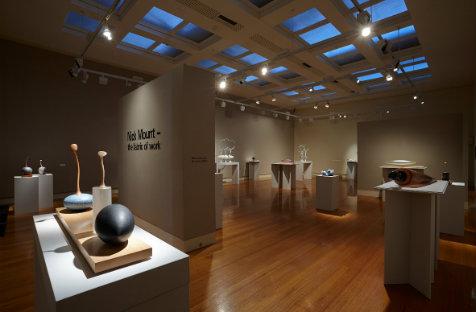Nick Mount (born Adelaide, 1952) is the embodiment of a disciplined artist. A figurehead in the Australian studio glass movement, Mount’s work ethos insists on a healthy respect for the tools used in glassmaking, of maintaining a constant regime of studio time, and always pushing the boundaries of his medium through continuous making. A high level of skill is evident in the acutely detailed pieces he creates, and the pleasure Mount has derived from the process of hot glass blowing over his 40 year career is positively trumpeted out of the luminously colorful, endlessly variable ‘scent bottles’ which he has been exploring since 1997. These are studies: experiments in variations of form by the hand of a master craftsman, and exquisitely pleasurable to view.
Currently on show at the Geelong Gallery are a selection of hung and ‘reclining bob’ forms with intricately patterned exteriors. The naming is a nod to the exhibition title, the fabric of work, as they are shaped like the ‘plumb bob’ tool, which is attached to a string and used in glass making. Humor is not lost in the titles accompanying some of the ‘scent bottles’ displayed in symbiotic pairs, with titles such as Pear with a can of Pears #080312 2012. This piece consists of one vessel shaped like a can, the other a curvaceous pear, each with a hand-carved olivewood stem, the can of pear’s stem curving protectively around the pear-shaped vessel. The suggestion of a relationship between the two is echoed in the title.
Outlandishly shaped and freely adopting traditional techniques, Mount’s scent bottles showcase the seductive and elusive qualities that can be achieved in glass. The phoenix-like quality of hot-blown glass in particular – born from fire with the artist’s breath giving it form – adds an air of theatre and mystique. Notably, all of the vessels are empty, void of the precious liquid a scent bottle would normally hold. They contain only light, and suggest at scent through colour, texture, and pattern, holding our imagination captive. Peepholes are a recurrent feature; the pieces are lined up to allow the viewer to see the insides of the works, to see through them (opaque glass is no hurdle, then, for the inquisitive visitor.)
Centre-stage holds the teal and white grand showpiece Scent bottle #030808 2011. The fragility of the piece is audible when you come within a one-metre radius of the work; the tinkling noise of the three-piece vessel shifting its weight is an unnerving experience.
Mount’s love affair with hot blown glass stemmed from a fortuitous meeting with the esteemed glass master Richard Marquis (b.1945) in 1975, who he assisted in conducting hot glass blowing workshops in Victoria and Tasmania that year. Marquis’ roots lay in the West Coast of the USA, where the funk craft movement preceded the 1970s American studio glass movement. This individually focused, self-expressive style had an enormous influence on Mount. After visiting California, Mount mixed this influence with the industrial-scale handcrafted style of glass production in Venice and Scandinavia. The fusion of traditional and contemporary glass-blowing methods served as a basis for the set-up of his long-lived studio, which opened under the name Budgeree Glass in 1978.
Looking to the future, the single piece Plum #010512 (2012), with its cross-hatched style pencil markings, the ‘low fire surface decoration’, could be a hint at the direction to which Mount will turn next. This piece stands out among the others through its humble and earthy feel. Elements of this drawing technique are seen in the other works, with the spirograph-like, wispy, curvaceous lines floating throughout the vases, but unlike these, the cross hatchings in Plum #010512 bring the maker’s mark directly onto the surface, exuding warmth.
In the Australian cultural scene, crafts have an intriguing position and are a current hot topic. Crafts are harnessed for many purposes – from activism and self-expression, to utility. The importance and relevance of their display and handling is being discussed at places such as the National Gallery of Victoria and Craft Victoria, the latter organisation holding regular forums and continually try to push the concept of craft to new areas. Mount’s work belongs in this discussion, as he straddles the line between artisan and artist.
On a final note, the tension between Mount’s identity fluctuating between artist and artisan was embodied in the way in which the works in this exhibition were displayed.
The plinths used in the exhibition detracted from the show. An assortment of generic style, clunky white plinths were used, whose function was to hold the vases up to the viewer and be technically invisible – there but not there. These utilitarian platforms cheapened the beautifully carved wooden and metallic squares and sewn sacks that many of the glass vessels rested on, and could have been scaled in a better way, or perhaps of a finer material, to reflect the quality of the pieces.
Already a master of his trade, yet allowing himself to stay fresh by constantly exploring new territory in the poetry of glass – the possibilities of a limitless, endlessly shapeable form – it will be an intriguing journey to follow Mount’s trail of inquiry into the next decades.
Rating: 3 stars out of 5
Nick Mount – the fabric of work
Geelong Gallery
16 February – 12 May





